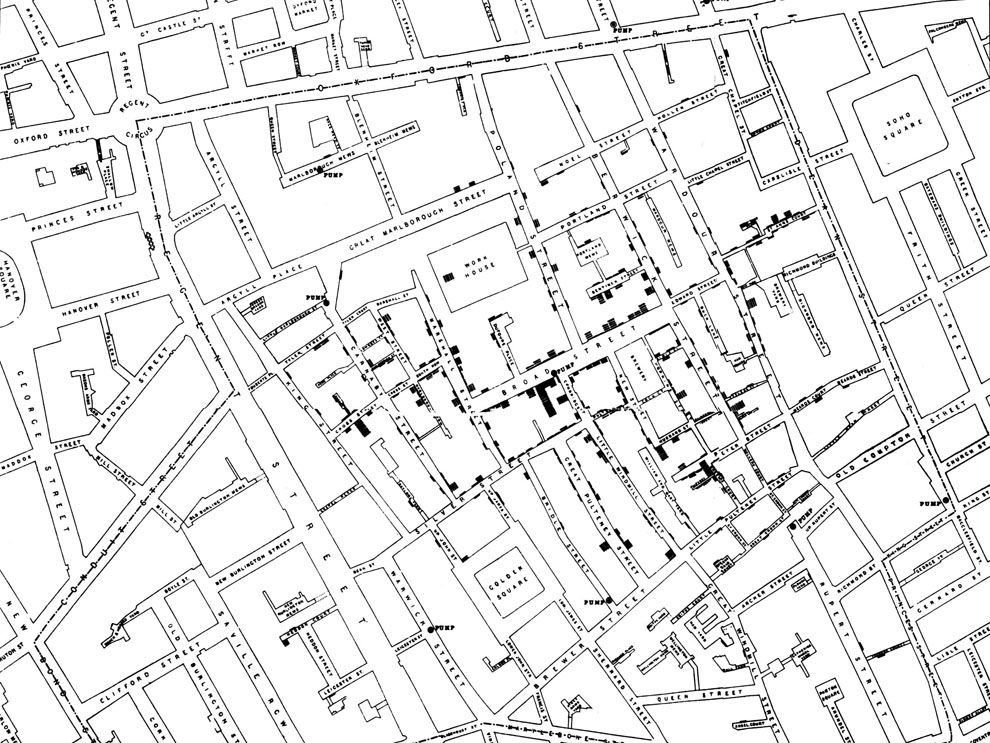1854 Broad Street Cholera Outbreak I
Previously, we covered the 2010 Haiti earthquake and the cholera outbreak. Cholera, an acute diarrhoeal infection resulting from the ingestion of water or food contaminated by the Vibrio cholerae bacteria, has plagued the human population for centuries ago. However, it was the 1854 Broad Street cholera outbreak when cholera was proven to be a water-borne disease, with significant links to drinking water sources polluted by human waste.
In the fall of 1854, Soho, Broad Street in central London, was hit by the cholera epidemic. Over 10 days, approximately 600 deaths occurred due to cholera, making it one of the most severe cholera outbreaks in UK history (Tulchinsky, 2018). Miasma, otherwise known as “bad air”, was commonly believed to have been the cause of cholera. Consequently, 75% of Soho residents left behind their shops and houses and moved away; lower-income families, however, could not afford to move elsewhere and were left with no choice but to stay in the cholera-plagued Soho (Summers, 1989).
Soho, in itself, was a poor district with pollutive industries and unsanitary housing. Untreated sewage from businesses and households was disposed into cesspools or directly into River Thames. Soho residents also tapped on public wells and communal pumps for drinking and non-drinking purposes. Disapproving the miasma theory, John Snow, an English physician, theorized that cholera was a water-borne disease. Snow thus set out to establish the relationship between the Broad Street Pump and cholera cases in Soho. Snow’s investigation demonstrated that most cholera cases were congregated around the Broad Street Pump, which residents frequent for drinking water. In cholera cases located further away, these individuals also consumed water from the Broad Street Pump, on their way to and from work or school.

Figure 1: Map of the 1854 Broad Street cholera outbreak by John Snow (National Geographic Society, 2014)
Interestingly, a workhouse and a brewery operating near the pump were largely unaffected by the cholera epidemic. This was attributed to alternative drinking water sources. The workhouse had a private well and outsourced water from the Grand Junction Water Works, while the brewery workers drink malt liquor from the company, which was made using water from their private well (Tuthill, 2003). Snow thus concluded that the Broad Street Pump was contaminated, and residents became infected with cholera after consuming water from the pump. Though, Snow could not figure out the source of this contamination. Nonetheless, he convinced officials to remove the pump handle, and the already dwindling cases came to a stop a few days later.
References
National Geographic Society. (2014). Mapping a London Epidemic [Photograph]. http://www.nationalgeographic.org/activity/mapping-london-epidemic/
Summers, J. (1989). Broad Street Pump Outbreak. University of California, Los Angeles. https://www.ph.ucla.edu/epi/snow/broadstreetpump.html
Tulchinsky, T. H. (2018). John Snow, Cholera, the Broad Street Pump; Waterborne Diseases Then and Now. Case Studies in Public Health, 77–99. https://doi.org/10.1016/B978-0-12-804571-8.00017-2
Tuthill, K. (2003). John Snow and the Broad Street Pump: On the Trail of an Epidemic. University of California, Los Angeles. https://www.ph.ucla.edu/epi/snow/snowcricketarticle.html